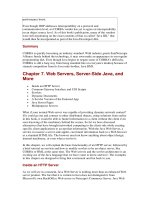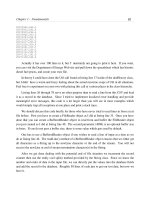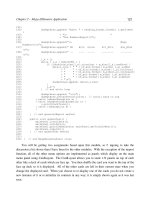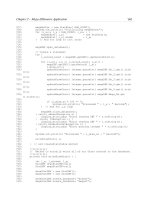Java and Security
Bạn đang xem bản rút gọn của tài liệu. Xem và tải ngay bản đầy đủ của tài liệu tại đây (132.45 KB, 15 trang )
objects produced as part of an application's shutdown process; as part of the
application's startup process, it retrieves the object from the server and picks up where
it left off. The best part is that this is just the normal way that Directory Servers do
business (i.e., binding names to objects).
Chapter 13. Java and Security
•
Safety in Java
•
The Java Security Model
•
Java Class Security
•
Encryption
•
Authentication
•
Secure Sockets Layer
•
The Government and Security
We have all heard that Java is a "secure" programming language. What exactly does
that mean? In this chapter, we discuss the unique features of Java that make it the
ideal choice for distributed network programming. Furthermore, we will discuss the
nuances of the applet host security model, as well as how security is handled from
within your Java applications.
We will also touch very briefly on Internet security and some of the alternatives you
may want to explore in your own networked applications to make them safe for cross-
network transmission. We begin our examination with the topic of cryptography. The
primary goal of cryptography is to provide data privacy, but, as we will see,
cryptography can be used to provide other essential security principles including
nonrepudiation, data integrity, and access-controlled authentication. We will then look
at the issues surrounding authentication, a security process that attempts to identify a
participant (user, server, and applet) transaction.
Safety in Java
When we refer to Java as a safe language, we are referring to the fact that you cannot
"shoot yourself in the foot." There are no memory leaks, out of control threads, or
chance of ending up in the dark spiral of C++ debugging. Make no mistake—Java is a
powerful language, and you will always end up with the possibility of sitting in an
infinite loop. You can still freeze your Java code with thread deadlocks, and you can
certainly end up accessing parts of an array that aren't really there. In short, Java is
safe, but it isn't idiot-proof. The fact remains that, in order to screw up your Java
programs, you still have to make a major effort.
Most Java programmers are pleased that Java has no pointers to memory locations.
This makes program debugging much easier, and it also makes security verification
possible. It cannot be verified at compile time that a pointer will do no harm. It can be
loaded at runtime with a naughty address to poke a hole in the password file or branch
to some code that sprinkles at-signs all over a disk. Without pointers, Java ensures
that all mischief is done within the downloaded applet running inside a Java Virtual
Machine. Moreover, memory is not allocated until runtime, and this prevents hackers
from studying source code to take advantage of memory layout because it is not
known at compile-time. Attempts to write beyond the end of an array, for example,
raise an ArrayIndexOutOfBoundsException. Had the C language had this feature
(array bounds checking), the infamous Morris Internet worm would not have been
able to trick the sendmail daemon (running with root privileges) into giving root
access to the worm.
Garbage collection, exceptions, and thread controls are part of Java no matter how
you try to use it. But, security and safety are two entirely different things. Safety
refers to protecting ourselves from our own misadventures. Security refers to
protecting ourselves from other people's devices. Because Java objects are loaded
dynamically, Java ensures that the objects are "trusted." Java's class security
mechanism makes sure that your applications are using the proper objects and not an
object that someone has slipped into the download stream to wreak havoc on your
machine.
The Java Security Model
The Java security model has been a constantly evolving part of Java. In the JDK 1.0
model, the "sandbox" concept was introduced. In the sandbox model, all local code
(JDK-provided code) was run as part of the Java Virtual Machine, and all code
retrieved from remote servers (applets) was run in a "sandbox" area of the JVM that
provided only a limited set of services. The reason for doing this was based on the fact
that any remotely retrieved code could be hostile. To protect the local machine the
sandbox provided only minimal access to the machine resources (Figure 13-1).
Figure 13-1. JDK 1.0 sandbox model.
The JDK 1.1 added to the JDL 1.0 security model the concept of "trusted applets" that
could run with the same privileges with respect to the local hosts system resources as
local code. This was done through the advent of the Java Archive file format and the
inclusion of a correctly signed digital signature in the JAR file. Unsigned applets in
JDK 1.1 sill run in the sandbox (Figure 13-2).
Figure 13-2. JDK 1.1 security model.
The JDK 1.2 evolves the security model by changing the goals to make it:
1. Easy to use fine-grained access control
2. Easy to configure security policy
3. Easy to extend the access control structure
4. Easy to extend security checks to Java applications as well as applets (Figure
13-3).
Figure 13-3. JDK 1.2 security model.
Easy to Use Fine-Grained Access Control
Fine-grained security has always been a part of Java; the main problem was that the
JDK 1.0 and 1.1 models made it extremely hard to use. To get the degree of control
required, subclassing and customizing of the SecurityManager and ClassLoader
classes is required (not a task for the uninitiated or the faint of heart). This required
quite a bit of programming and an in-depth knowledge of computer and Internet
security.
Easy to Configure Security Policy
Because of the amount of code required to configure security policy with the earlier
JDKs, it would be more user friendly if the software developers and users could easily
configure the security policy via an external policy file built with either a text editor
or a GUI tool.
Easy to Extend Access Control Structure
To extend the access control structure in JDK 1.1 required adding additional "check"
methods to the SecurityManager class. The new model does not require the addition
of new "check" methods to the SecurityManager; the new architecture is based on
permissions in the policy file. Each permission defines access to a system resource.
Easy to Extend Security Checks to Applications
In an effort to simplify things and have all code treated equally, the JDK 1.1 concept
of "trusted" code was dumped in favor of a model where all code (local or remote) is
treated equally, including JDK 1.1 trusted applets. It is for this reason that some JDK
1.1 applications and trusted applets will fail with security exceptions when run under
the JDK 1.2 virtual machine.
Java Class Security
Java's security model is made up of three major pieces:
•
The Bytecode Verifier
•
The Class Loader
•
The Security Manager
The Bytecode Verifier
The designers of Java knew that applets could be downloaded over unsecured
networks, so they included a bytecode verifier in the Java Virtual Machine's
interpreter. It checks to make sure that memory addresses are not forged to access
objects outside of the virtual machine, that applet objects are accessed according to
their scope (public, private, and protected), and that strict runtime type enforcement is
done both for object types and parameters passed with method invocations. The
bytecode verifier does these checks after the bytecodes are downloaded but before
they are executed. This means that only verified code is run on your machine; verified
code runs faster because it does not need to perform these security checks during
execution.
The Class Loader
Each imported class executes within its own name space. There is a single name space
for built-in classes loaded from the local file system. Built-in classes can be trusted,
and the class loader searches the local name space first. This prevents a downloaded
class from being substituted for a built-in class. Also, the name space of the same
server is searched before the class loader searches other name spaces. This prevents
one server from spoofing a class from a different server. Note that this search order
ensures that a built-in class will find another built-in class before it searches an
imported name space. So, when classes are downloaded, the client's built-in classes
are used because they are trusted (See Figure 13-4).
Figure 13-4. Downloaded Java objects use the local built-in classes rather than their
own.
The Security Manager
New to Java in the JDK 1.2 is the ability to define a security policy that can be
defined for each application separately from the Java code in a policy file. The policy
defined in this external file is enforced at runtime by the Java security manager class.
Java classes that have the possibility of doing things that might violate the security
policy have been rewritten to include checks of the defined policy so as to verify that
the application writer really wants to allow certain operations.
Java 1.2 Security Policies
New to Java with the release of Java 1.2 is a methodology that provides a much finer-
grained approach to the security of important system resources like the file system,
sockets access, system properties, runtime facilities, and security facilities themselves.
This is done by establishing security policies; when an application/applet/servlet is
loaded, it is assigned a set of permissions that specify the level of access (read, write,
connect,…) that the code has to specific resources. If code isn't specifically given
permission to access something, it won't be able to. These sets of permissions are
specified in an external text file called a policy file. Policy files can be created with a
text editor or by using the policy tool that comes with the JDK.
For the sample code in this book, a policy file called "policy.all" is provided on the
CD. This file will grant all permissions to everything (which is good for the purposes
of this book but bad from the standpoint of production code deployment; code placed
into a production environment should define only the permissions that it needs to run).
Policy Files
Policy files are made up of a set of "grant" statements that have the general form of:
Grant [SignedBy "signer names"] [, CodeBase "URL"]
{
permission "permission_class_name" ["target name"]
[, "action"] [, SignedBy, "signer names"];
permission. . ..
}
where
•
SignedBy—Indicates that this is signed code (as in a signed JAR file) and that
signatures should be checked. This is used to verify that downloaded code is
from a trusted source. This is an optional attribute; if it is absent, signature
checking is skipped.
•
CodeBase—A URL (usually either http:// or file://) of either a file or a
directory to the grant applies.
•
permission—The class that enforces the policy; the most commonly used are:
o
java.io.FilePermission—access to files
o
java.io.SocketPermission—access to sockets
o
java.lang.RunTimePermission—access to threads and system resources
o
java.util.PropertyPermission—access to properties
•
target—A path to the resource. This is optional and, if absent, refers to the
current directory.
•
action—Operations allowed (read, write, execute, delete).
•
SignedBy—Signers of the permission classes; if signers can't be verified, the
permission is ignored.
There are, by default, two policy files that establish the permissions that an
application runs under—a system-wide policy file and an optional user (application)
specific policy file. The system-wide policy file is kept in
/java.home/lib/security/java.policy (java.home is a system property that contains the
name of the directory that the JDK is installed in).
The default policy java.policy follows. It grants all permissions to standard extensions,
allows anyone to listen in on ports above 1024, and allows any code to read standard
system properties that aren't considered sensitive.
grant codeBase "file:${java.home}/lib/ext/*" {
permission java.security.AllPermission;};
// default permissions granted to all domains
grant
{
// Allows any thread to stop itself using the
// java.lang.Thread.stop() method that takes no argument.
// Note that this permission is granted by default only to remain
// backwards compatible.
// It is strongly recommended that you either remove this
// permission from this policy file or further restrict it to code
// sources that you specify, because Thread.stop() is potentially
// unsafe. See " for more information.
// permission java.lang.RuntimePermission "stopThread";
// allows anyone to listen on un-privileged ports
// permission java.net.SocketPermission "localhost:1024-",
"listen";
// "standard" properties that can be read by anyone
permission java.util.PropertyPermission "java.version", "read";
permission java.util.PropertyPermission "java.vendor", "read";
permission java.util.PropertyPermission "java.vendor.url", "read";









